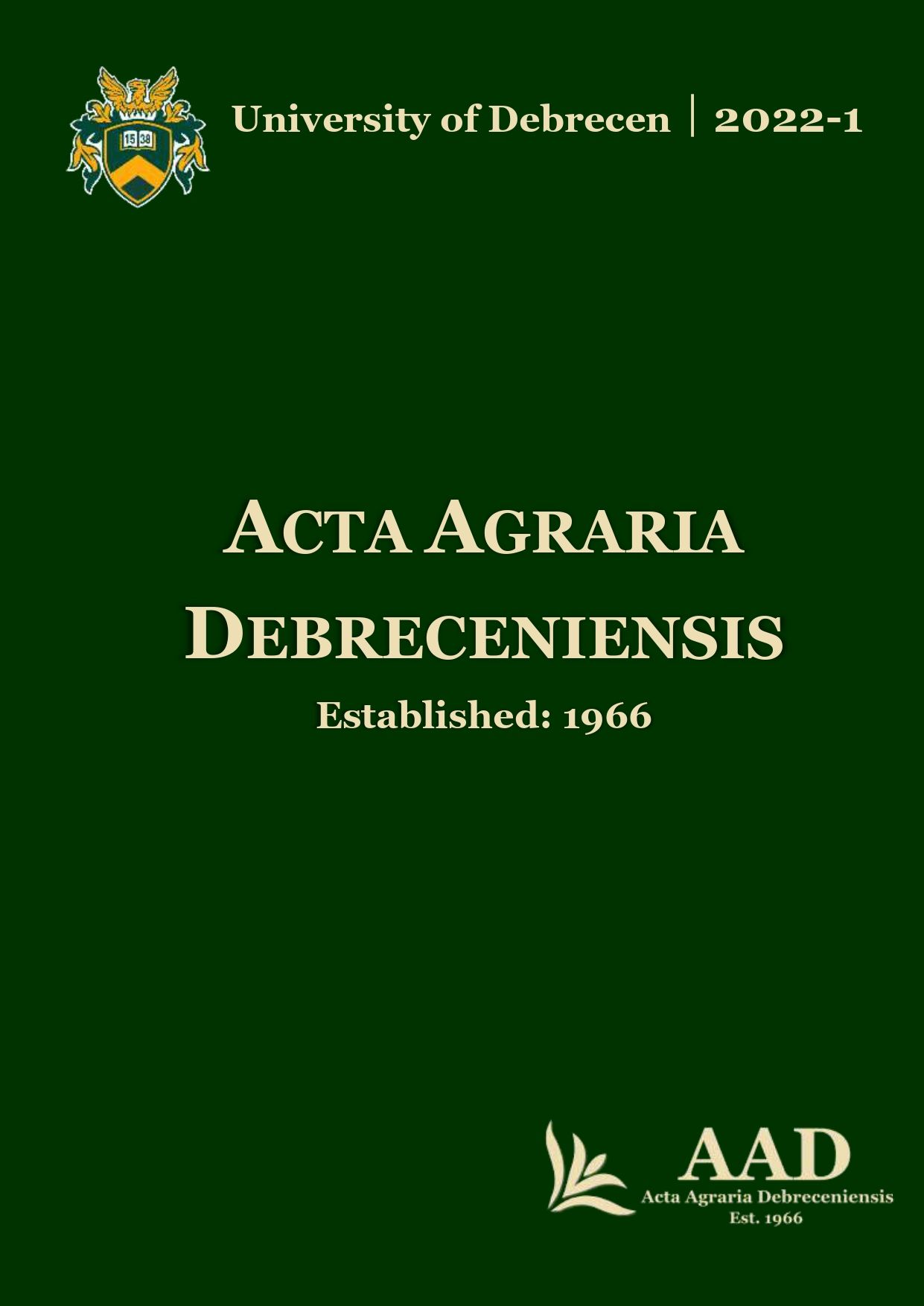Inhibition of the spread of Sclerotinia sclerotiorum in aquaponics
Authors
View
Keywords
License
Copyright (c) 2022 by the Author(s)

This work is licensed under a Creative Commons Attribution 4.0 International License.
How To Cite
Accepted 2022-04-11
Published 2022-05-26
Abstract
Sclerotinia sclerotiorum, which causes white mold, is a widespread pathogen. In 2020, a new host plant of this fungus, the watercress (Nasturtium officinale) was identified in Hungary in an aquaponic system. During the cultivation of watercress S. sclerotiorum was detected on the plant, the fungus caused a 30% yield loss. Fungicides should not be used against fungi in aquaponic systems. Non-chemical methods of integrated pest management should be used. These include biological control (resistant species, predators, pathogens, antagonist microorganisms), manipulation of physical barriers, traps, and the physical environment. In the aquaponic system, the removal of the growing medium (expanded clay aggregate pellets) solved the damage of Sclerotinia sclerotiorum 100%. By removing the expanded clay aggregate pellets, the environmental conditions became unfavorable for the development and further spread of the S. sclerotium fungus.
References
- Blüthner, W.D. (2020): Nasturtium officinale R. Br.: Watercress. In: Medicinal, Aromatic and Stimulant Plants. Editor Novak J., Blüthner, W. D. Eds.; Publisher: Springer, Volume 12, pp. 333–344.
- Boland, G.J.–Hall, R. (1994): Index of plant hosts of Sclerotinia sclerotiorum. Canadian Journal of Plant Pathology, 16:2, 93–108.
- Bolton, M.D.–Thomma, B.P.–Nelson, B.D. (2006): Sclerotinia sclerotiorum (Lib.) de Bary: biology and molecular traits of a cosmopolitan pathogen. Molecular Plant Pathology. 7:1, pp.1–16.
- Bown, D. (1995): Encyclopaedia of herbs and their uses. 1st American ed.; Publisher: London, New York, Dorling Kindersley.
- Bulya, E.T.–Gluhareva, T.–Adepoju, F.O.–Salazar, J.X. (2020): The use of aquaponic system to evaluate suitable conditions for improved organic plant growth. AIP Conference Proceedings 2280, 030003
- Csüllög, K.–Tóth, B.–Lelesz, É. J.–Fehér, M.–Virág, Cs.I.–Kutasy, E.–Jász, B.–Tarcali, G.–Biró, Gy. (2022): First report of Sclerotinia sclerotiorum on watercress (Nasturtium officinale) in aquaponic system in Hungary. Plant Disease. 106:2, pp.767.
- Downey, R.K.–Rimmer S.R. (1993): Agronomic Improvement in Oilseed Brassicas. In: Advances in Agronomy; Editor: Donald L. Sparks, Publisher: Academic Press, Volume 50, pp. 1–66.
- Farr, D.F.–Bills, G.F.–Chamuris, G.P.–Rossman, A.Y. (1989): Fungi on Plants and Plant Products in the United States. APS Press, St. Paul, MN, ISBN 0-89054-099-3
- Garibaldi, A.–Bertetti, D.–Pensa, P.–Matié, S.–Gullino, M.L. (2019): First Report of White Mold Caused by Sclerotinia sclerotiorum on Watercress (Nasturtium officinale) in Italy. Plant Disease, Volume 103, No 1., pp. 151–152.
- Giallourou, N.–Oruna-Concha, M.J.–Harbourne, N. (2016): Effects of domestic processing methods on the phytochemical content of watercress (Nasturtium officinale). Food Chemistry, 212:411–419.
- Gonçalves, E.M.–Cruz, R.M.S.–Abreu, M.–Brandão, T.R.S.–Silva, C.L.M. (2009): Biochemical and colour changes of watercress (Nasturtium officinale R. Br.) during freezing and frozen storage. Journal of Food Engineering, 93:1, 32–39.
- Gosh, K.–Chowdhury, S. (2019): Review of Aquaponics System: Searching for a Technically Feasible and Economically Profitable Aquaponics System. Journal of Agricultural, Environmental and Consumer Sciences. Volume 19, pp. 5–13.
- Hamzeh, A. (2012): Volatile constituents and antioxidant activity of flowers, stems and leaves of Nasturtium officinale R. Br., Natural Product Research, 26:2, 109–115, DOI: 10.1080/14786419.2010.534998
- Ibrahim, H.M.–Kusch, S.–Didelon, M.–Raffaele, S. (2021): Genome-wide alternative splicing profiling in the fungal plant pathogen Sclerotinia sclerotiorum during the colonization of diverse host families. Molecular Plant Pathology, 22:1, pp. 31–47.
- Kara, Y.O.–Basaran, D.–Kara, I. (1999): The research on Cu++ metal bioabsorption with Nasturtium officinale. Biochemical Archives, 15:4, pp. 305–310.
- Kara, Y.O. (2002): Phytoremediation: using Nasturtium officinale to clean up Zn++−contaminated wastewater. Fresenius Environmental Bulletin. 11:12A, pp. 1084–1086.
- Lennard, W.–Goddek, S. (2019): Aquaponics: The basics. In: Aquaponics Food Production Systems; Springer Nature: Cham, Switzerland, p. 113.
- Mordue, J.E.M.–Gibson, I.A.S.–Holliday, P.–Critchett, C.–Punithalingam, E.–Mulder, J.L. (1976): C.M.I. Descriptions of Pathogenic Fungi and Bacteria. Publisher: Commonwealth Mycological Institute Kew UK. pp. 511–520.
- Mori, J.–Smith, R. (2019): Transmission of waterborne fish and plant pathogens in aquaponics and their control with physical disinfection and filtration: A systematized review. Aquaculture, 504, pp. 380–395.
- Palm, H.W.–Seidemann, R.–Wehofsky, S.–Knaus, U. (2014): Significant factors affecting the economic sustainability of closed aquaponic systems. Part I: system design, chemo-physical parameters and general aspects. AACL Bioflux. 7:1, pp. 20–32.
- Rakocy, J.E.–Masser, M.P.–Thomas, M.–Losordo, T.M. (2017): Recirculating Aquaculture Tank Production Systems: Aquaponics-Integrating Fish and Plant Culture. SRAC Publication. No. 454. pp. 1–16.
- Rivas-García, T.–González-Estrada, R.R.–Chiquito-Contreras, R.G.–Reyes-Pérez, J.J.–González-Salas, U.–Hernández-Montiel, L.G.–Murillo-Amador, B. (2020): Biocontrol of Phytopathogens under Aquaponics Systems. Water. 12:7, 2061.
- Smith, E.N. (2007): Watercress (Nasturtium officinale) production utilizing brook trout (Salvelinus fontinalis) flow-through aquaculture effluent, West Virginia University. Available online: https://researchrepository.wvu.edu/cgi/viewcontent.cgi?article=5373&context=etd (accessed on 26. 12. 2021.).
- Zargari, A. (1987): Medicinal plants. Publisher: Tehran University Press. Vol. 1, pp. 199–204.

 https://doi.org/10.34101/actaagrar/1/10736
https://doi.org/10.34101/actaagrar/1/10736